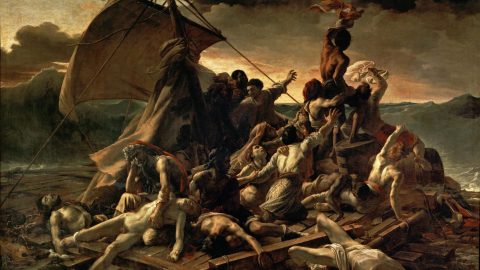Shipwrecked: Leadership lessons from history’s famous castaways

It’s the early 20th century, and you are the captain of a ship. A barquentine specifically—three masts and a coal-burning steam engine in her belly. She’s a sturdy and capable vessel, and that’s good because you’ve been tasked with sailing her and a 27-man crew to make the first land crossing of the Antarctic continent.
It won’t go well.
Your ship soon becomes ensnared in the floe. As you drift through uncharted southern seas, winter winds pummel your crew and the ever-growing pack ice presses hungrily against the ship’s hull. One day your world cants, then cracks. You must abandon the ship, marooned on the wintery continent with no hope of resupply or rescue. How do you lead your crew under such conditions and mental strain?
While this scenario is only hypothetical for us, it was the terrifying reality faced by Sir Ernest Shackleton during the Imperial Trans-Antarctic Expedition.
The hardships outlined above were—say it with me now—the tip of the iceberg for Shackleton and his crew. Yet, remarkably, they were able to cross the barren and brutal ice packs of Antarctica, sail lifeboats to Elephant Island, and then send a small party to find help at South Georgia. No lives were lost.
As Nicholas Christakis, director of the Human Nature Lab at Yale, can tell us, not every shipwrecked crew had leadership to match Shackleton’s sterling example. Christakis has analyzed close to 20 such historical cases and has extrapolated best practices leaders must consider if they are to avoid disaster.
In this video lesson, he shares a few of his findings.
The Kind of Leadership We Desire
- Humans evolved to prefer leaders who:
- Manifest mild hierarchy (not too autocratic, not too egalitarian)
- Command authority through prestige (not just powerful, but knowledgeable)
- Maintain group cohesion (able to suppress violence and conflict)
We’re a Goldilocks species. We prefer our porridge not too hot, not too cold; our beds not too soft, not too hard; and our leaders not too autocratic but not too egalitarian.
As Christakis’s examples make clear, leadership is a balancing act. You need authority to make have people follow you (autocratic), but you need to let your team maintain some control over the mission and grow in their roles (egalitarianism). You must be knowledgeable but also access the expertise of others. And you must allow for healthy debate—even regarding your cherished beliefs and ideas—while stamping out debate that could escalate to conflict and schism.
We should be careful here, though. We aren’t saying a quality leader is both autocratic and egalitarian. Rather, we’re saying that these two qualities exist on a continuum. A good leader finds the right place on that continuum for their team, their mission, and the challenges they face.
As Christakis points out, Shackleton found that balance. He knew certain commodities needed to be shared equally with no regard for rank (food), but that chain of command needed to be ironclad for the crew to maintain group cohesion. Without that cohesion, they could never have survived the perils and mental stresses they faced.
Essential Questions for Leading Teams in Crisis
- Am I setting the right tone?
- What’s our group mindset?
- How can I communicate that we’re all in it together?
- Am I maintaining group cohesion?
- How can I move my team members in the same direction?
- How can I model civic-mindedness?
To modernize Christakis’s shipwreck examples, if a workplace’s tone feels like a season of Survivor—with its motto of “Outwit, Outplay, Outlast”—then leadership has failed. Down such a path are far greater consequences than being voted off the island.
Leaders need to express cohesion to move their teams in the same direction. That can be tricky, especially when individuals have their egos, beliefs, and career progression on the line. But we can also accomplish more as a team than we can as individuals because teammates can use their skills and knowledge to supplement our weaknesses, and vice versa.
The key then is to discover ways to tie individual success and team success together, like barquentine masts catching the same favorable wind. Sounds easy enough, but remember that one of those South Auckland shipwrecks devolved into disunion and cannibalism despite their very survival riding the line.
It takes hard work, dedication, and a consistent message to lead teams to civic-mindedness—in times of crisis or not.
Keep your organization from running aground with lessons ‘For Business‘ from Big Think+. At Big Think+, Nicholas Christakis joins more than 350 experts to teach leading change and energizing team innovation. Develop your leadership skills with video lessons such as:
- Overcome Obstacles, with Edward Norton, Actor and Co-Founder, Crowdrise
- Strengthen Your Emotional Agility: Becoming an Agile Leader, with Susan David, Psychologist, Harvard Medical School, and Author, Emotional Agility
- A Navy SEAL’s Guide to Winning the Fight for Change: The Fundamentals of Culture-Driven Transformation, with Brent Gleeson, Business Consultant, Former Navy SEAL, and Author, Taking Point
- A Great Place to Work for All: Deciding to Lead in a Different Way, Michael C. Bush, CEO, Great Place to Work, and Author, A Great Place to Work for All
- Understand the Neurobiology of Hierarchy: What People at the Top Can Do to Support the People Below Them, with Robert Sapolsky, Neuroscientist and Author, Behave
Request a demo today!




